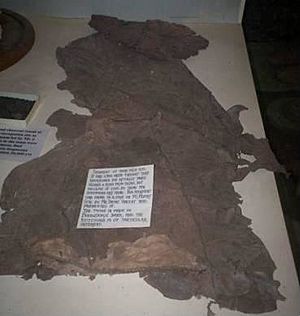Indigenous Collection (Miles District Historical Village) facts for kids
The Indigenous Collection at the Miles District Historical Village is a special group of Australian Aboriginal artefacts. These items come from the local area and western Queensland. Some of them are very rare and important to Australia's history. They show the strong connection to Indigenous Australians. The Miles District in south-east Queensland was home to the Barunggam people. It was also a stopping point for other Aboriginal peoples traveling through.
Contents
A Look Back: The Barunggam People and Their Land
The Barunggam people lived in a large area. This stretched from Tchanning Creek near Yuleba in the west. It went to Myall Creek near Dalby in the east. To the north was the Great Dividing Range. To the south were the Moonie and Condamine rivers.
Sadly, there are no known Barunggam descendants living in this area today. The Barunggam people were moved to Taroom in 1916. Later, they were moved again to places like Cherbourg or Woorabinda.
You can still find signs of Aboriginal life in the area. On sandstone rocks near L Tree Creek, north of Miles, you can see grooves. These grooves show where spears were sharpened. Along Dogwood Creek and at Chinaman's Lagoon, Aboriginal people used to stop and eat. There are old piles of middens (mussel shells) on the Condamine River. You can also find them at the Round Waterhole north of Dulacca.
This region was also a key stop for other Aboriginal groups. Every three years until 1876, they traveled through. Their journey led them to the Bunya Mountains. There, they would gather the ripe bunya nuts. The Village collection includes the "Ilbalunga Cave." This cave shows what a resting spot looked like. Local Aboriginal people helped create it. They decorated the cave with their hand prints.
The collection has many interesting items. There is a map showing traditional tribal areas. You can see many rubbing stones, boomerangs, and stone axes. There are also grinding and milling stones and other tools. Most of these items came from the Keenan and Mayfield families. The collection also has dilly bags and other handmade items. Some very special items are a koala skin rug, an old notice about the Aboriginal Protection Act, and a chest plate. You can learn more about these below.
The Koala Skin Rug: A Rare Treasure
This koala skin rug is very special. Not many rugs made by Aboriginal people still exist today. This makes it a rare and important historical item. It shows amazing Aboriginal craftsmanship. Researchers can also learn about old sewing and rug-making methods from it. Mr. Dayne Vincent found the rug in a cave. This cave was on Mt Moffatt Station, near Roma. The string used is made from boodioorie bark. The way it is stitched is very unusual. The rug would have been warm and cozy. Koala fur is thick and soft.
Other koala skin rugs are in Australian museums. But most of these were not made by Aboriginal people. They were made after British colonisation. At that time, native animal furs were used for clothes and other goods. Millions of koalas were killed for their fur until the 1930s. Then, state governments started protecting them. This helped their numbers grow again and stopped the fur trade. Today, koalas are protected by law in all states and territories where they live.
An Important Notice: The Aboriginals Protection Act
This old notice is about the Aboriginals Protection and Restriction of the Sale of *** Act 1897. It came from Taroom. It was displayed in the old Police Station for over 50 years. It might have been there since 1897. The notice is written in English and Chinese. It could be very rare, as no other copies are known.
This Act had a big impact on Aboriginal people's lives. It limited their rights and freedoms. It set up special Aboriginal reserves. These were isolated areas. Aboriginal people could be forced to move to these reserves. Special officers, called Protectors of Aborigines, could make them move. These officers were government workers, police, or missionaries. Later, Aboriginal Protection Boards controlled these areas.
The Act said these reserves would protect Aboriginal people. But in reality, it controlled their lives. It also took away many of their basic rights. This Act was finally changed by the Community Services Act 1984.
King Dick of Boondie Plate: A Symbol of Leadership
King plates were special metal plates. White colonial leaders in Australia used them before the country became a federation. They gave these plates to local Aboriginal leaders to show respect. This chest plate belonged to King Dick of Boondie. He was a chief of the Palparara tribe. They lived in western Queensland, near Winton and Windorah.
King plates were shaped like a crescent moon. They were made of metal and worn around the neck. They rested on the chest. This plate belonged to King Dick of Boondie. A 'boondie' is an Australian word. It means a piece of hardened sand that breaks off a larger sand pocket. You can throw it like a snowball. Boondies are common in Western Queensland.
Other known 'Kings' from the Miles district include King Billy of Tiereyboo. He came to live at Chinaman's Lagoon (near Miles) in the early 1900s. There was also King Sandy of Moraby. Tiereyboo was one of the first land holdings in this area. It was located between the Condamine River and Dogwood Creek. Moraby was another early land holding, located further west.
See also



